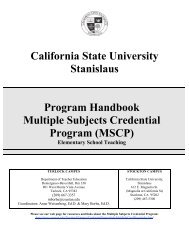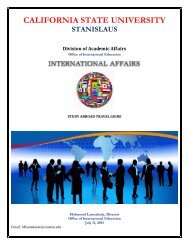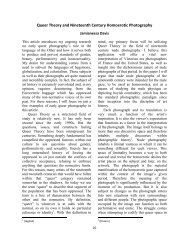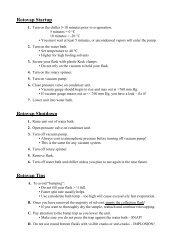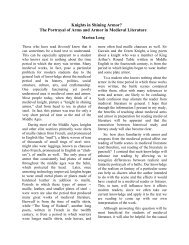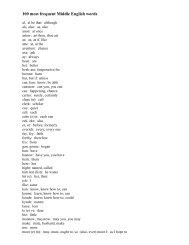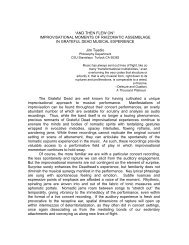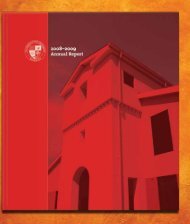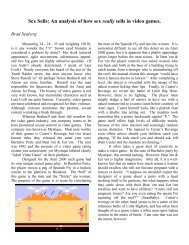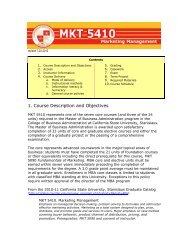Exploring the Benefits of Art in Elementary Education
Exploring the Benefits of Art in Elementary Education
Exploring the Benefits of Art in Elementary Education
You also want an ePaper? Increase the reach of your titles
YUMPU automatically turns print PDFs into web optimized ePapers that Google loves.
it seemed that this deficiency was detrimental<br />
to <strong>the</strong> learn<strong>in</strong>g environment. I found that<br />
students who had difficulty express<strong>in</strong>g<br />
<strong>the</strong>mselves verbally or through writ<strong>in</strong>g could<br />
express <strong>the</strong>mselves magnificently through<br />
illustration. This was particularly evident at<br />
<strong>the</strong> k<strong>in</strong>dergarten level. Over <strong>the</strong> past three<br />
years I have done over one hundred hours <strong>of</strong><br />
observation <strong>in</strong> elementary classrooms and<br />
have noticed <strong>the</strong> effectiveness <strong>of</strong> art <strong>in</strong><br />
<strong>in</strong>struction. My goal is to exam<strong>in</strong>e <strong>the</strong><br />
importance <strong>of</strong> this neglected area <strong>of</strong><br />
education.<br />
The follow<strong>in</strong>g paper is organized <strong>in</strong>to<br />
three ma<strong>in</strong> sections. In <strong>the</strong> first section I will<br />
discuss how art helps bridge understand<strong>in</strong>g <strong>of</strong><br />
difficult subjects. Next I will discuss how No<br />
Child Left Beh<strong>in</strong>d (NCLB) has crippled <strong>the</strong><br />
art curriculum to <strong>the</strong> detriment <strong>of</strong> students.<br />
Therefore, <strong>in</strong> this project, described <strong>in</strong> <strong>the</strong><br />
third section, I will show how young students<br />
can use art to express <strong>the</strong>mselves as an<br />
alternative to verbalization.<br />
Wise Eisner. Thus far <strong>in</strong> my research, I have<br />
found a considerable amount <strong>of</strong> evidence to<br />
suggest that art’s <strong>in</strong>fluence on children helps<br />
<strong>the</strong>m to better succeed academically. There is<br />
def<strong>in</strong>itely a correlation between students’<br />
<strong>in</strong>volvement with art and <strong>the</strong>ir overall<br />
academic success. There are many important<br />
elements <strong>of</strong> a child’s cognitive development<br />
that are enhanced by art. Elliot Eisner, a<br />
major advocate for <strong>the</strong> arts, created a set <strong>of</strong><br />
examples <strong>of</strong> <strong>the</strong> importance <strong>of</strong> <strong>in</strong>clud<strong>in</strong>g art <strong>in</strong><br />
schools called: Ten Reasons to Teach <strong>Art</strong>.<br />
These reasons are listed <strong>in</strong> Eisner’s book<br />
entitled The <strong>Art</strong>s and <strong>the</strong> Creation <strong>of</strong> M<strong>in</strong>d<br />
(2002). One <strong>of</strong> <strong>the</strong> most important reasons<br />
listed is one that states: “The arts teach<br />
children to make good judgments about<br />
qualitative relationships. Unlike most <strong>of</strong> <strong>the</strong><br />
curriculum <strong>in</strong> which correct answers and rules<br />
prevail, <strong>in</strong> <strong>the</strong> arts it is judgment ra<strong>the</strong>r than<br />
rules that prevail” (Eisner, 2002). This is<br />
undoubtedly one <strong>of</strong> <strong>the</strong> biggest life lessons <strong>of</strong><br />
all and it can be well taught through art.<br />
57<br />
Instill<strong>in</strong>g this quality <strong>in</strong> children at a young<br />
age will help <strong>the</strong>m <strong>in</strong> becom<strong>in</strong>g more<br />
successful adults. Be<strong>in</strong>g able to make good<br />
judgments is an essential life skill as it is<br />
necessary <strong>in</strong> <strong>the</strong> workforce, <strong>the</strong> home and <strong>in</strong><br />
society <strong>in</strong> general. Hav<strong>in</strong>g <strong>the</strong> ability to use<br />
good judgment lends itself to good decision<br />
mak<strong>in</strong>g. <strong>Art</strong> has <strong>the</strong> ability to teach essential<br />
life lessons and so it too should be an<br />
essential subject at all levels <strong>of</strong> education.<br />
Elliot Eisner has long been recognized for<br />
his role not only as a teacher, but also as an<br />
advocate for <strong>the</strong> <strong>in</strong>clusion <strong>of</strong> arts <strong>in</strong> education.<br />
I th<strong>in</strong>k that what I learned most from Eisner’s<br />
ten criteria as a whole is that <strong>the</strong>y help to<br />
show how students have <strong>the</strong> ability to atta<strong>in</strong><br />
success not only <strong>in</strong>side <strong>the</strong> classroom, but <strong>in</strong><br />
<strong>the</strong> world as well. Leav<strong>in</strong>g art out <strong>of</strong> <strong>the</strong><br />
curriculum only has <strong>the</strong> potential to hurt<br />
students’ chances later <strong>in</strong> life.<br />
<strong>Art</strong> as presented by Eisner seems to<br />
improve <strong>the</strong> social attitudes <strong>of</strong> children.<br />
Open<strong>in</strong>g <strong>the</strong> idea <strong>of</strong> creativeness and<br />
alternativeness to a child allows for greater<br />
levels <strong>of</strong> acceptance and understand<strong>in</strong>g. I<br />
th<strong>in</strong>k that it is important for students to know<br />
that not everyone th<strong>in</strong>ks exactly alike and that<br />
alternative approaches to a problem are a<br />
good th<strong>in</strong>g. Students will come with <strong>the</strong>ir<br />
own mix <strong>of</strong> learn<strong>in</strong>g patterns which can ei<strong>the</strong>r<br />
be accepted or regarded as <strong>in</strong>correct ways <strong>of</strong><br />
th<strong>in</strong>k<strong>in</strong>g.<br />
Absence <strong>of</strong> <strong>Art</strong> Encourages Standardization.<br />
As teachers we are not rais<strong>in</strong>g robots. NCLB<br />
assessment is a means <strong>of</strong> mold<strong>in</strong>g students<br />
<strong>in</strong>to standard, diligent, and ultimately<br />
unth<strong>in</strong>k<strong>in</strong>g <strong>in</strong>dividuals. If we do not embrace<br />
<strong>the</strong> teach<strong>in</strong>gs <strong>of</strong> Eisner and take <strong>in</strong>to<br />
consideration <strong>the</strong> benefits <strong>of</strong> <strong>in</strong>corporat<strong>in</strong>g art<br />
we are only sett<strong>in</strong>g students up for failure.<br />
Allow<strong>in</strong>g for multiple perspectives early <strong>in</strong><br />
education helps promote understand<strong>in</strong>g and<br />
acceptance <strong>of</strong> o<strong>the</strong>rs while also help<strong>in</strong>g to<br />
create a desire to learn. I do not th<strong>in</strong>k that it<br />
is healthy for teachers and students to have to<br />
fear <strong>the</strong> classroom because <strong>of</strong> <strong>the</strong> current



